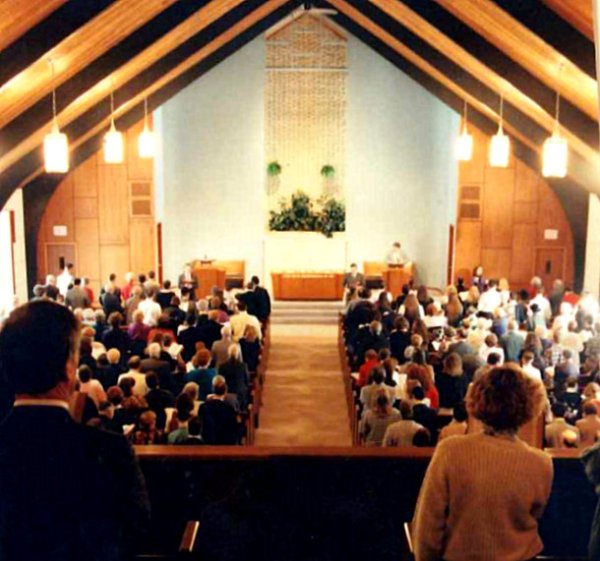One of the best parts of my job with InterVarsity is my mandatory retreat day. Multiple times a year, I’m required to spend a workday praying, reading, reflecting, and sometimes (usually) even napping. Last week, partially to avoid napping away the majority of my retreat, I decided to spend my day of reflection in downtown Detroit. My self-imposed itinerary led me to a number of locations, but the bulk of the day was spent at the Detroit Institute of Arts.
When I was in college, one of my mentors (Sara Barton) introduced me to the practice of listening for God’s voice in the arts. Central to this practice is the idea that—just as God can speak to us through other people or Creation—God sometimes speaks to us through other people’s creations.
Sara’s method was pretty simple: walk around a museum until a particular piece of art arrests your attention. Then, spend as much time as you can with that one piece. Ask yourself why you’re drawn to it, what it communicates about God, God’s image in the artist, and God’s Spirit in yourself. Talk to God about the art and the emotions it elicits. Pray, journal, read Scripture—all in conversation with God within the context of piece of art you selected.
It’s a practice I always admired, but never really tried. So I decided to give it a whirl last week at the DIA.
I entered the museum with a bit of an agenda: I was looking to spend time with a portrait or statue of Jesus. I wanted to see Jesus through the eyes of someone else, preferably someone from a long time ago. And thus, my quest to find Jesus began.
- Jesus is everywhere
I quickly discovered that there are a lot of Jesuses (Jesi?) at the DIA. He’s easily the most popular guy in the building. There are a couple large areas specifically set aside for Christian art, chapel-esque rooms filled with crucifixes and baby Jesuses.
But the Son of God is not confined to his designated section. Jesus appears in every corner, in almost every era and genre represented in the museum. Ancient, Baroque, Renaissance, Modern. Italian, Spanish, American, Arab, Asian, African. The only place I couldn’t find a Jesus was among the Islamic art (Muslims rarely portray humans in art, and never holy religious figures). I clearly had plenty of Jesuses to choose from. But none of them did it for me; none of them was my Jesus.
- Jesus isn’t looking so great
Part of my problem with the art I encountered was that, more often than not, Jesus looked just awful. Wherever I turned, I found another bloody, emaciated, exhausted Savior. This makes sense when it comes to the crucifixes—and there were a lot of crucifixes. But Jesus often looked pretty messed up in the other scenes too. He seemed sickly at the Last Supper. He was hunched and limping as he faced opposition in Galilee. Quite a few times, he was straight-up dead; there were far more depictions of Jesus’ burial than I had expected.
There’s a place and purpose for images of Jesus as Suffering Servant, but it seems as if—as a whole—western Christianity is disproportionately obsessed with watching him die. And not just in subtle, nuanced fashion; when Jesus suffers at the DIA, he suffers big. Dramatic lighting highlights the agony on his overly expressive face.
Within their original context the hyperbole in these pieces may have made sense, the way stage makeup works to make far-off actors seem more intimate. But up close at the museum, many just struck me as grotesque and other-worldly. The over-the-top suffering of Jesus made him seem disconnected from the actual pain of the real world. This wasn’t the Jesus I was searching for.
- Jesus hardly ever rises from the dead
The DIA’s Jesus art is dominated by nativity, crucifixion, and communion scenes; Christmas, Good Friday, and the Eucharist are well-represented. But our other big holiday, Easter, is almost entirely absent.
In the three hours I spent wandering the museum, I found at most 10 resurrected Jesuses—and that includes a couple baseball-card-sized etchings. These artists just don’t seem very interested in the risen Christ. A somber baby, a stressful dinner party, and a tortured martyr: these, according to this collection, are the central images of Christianity. The resurrection is more peripheral, like the fish and loaves or the sermon on the mountain.
What bothered me most, though, was how even back-from-the-dead Jesus looked pretty beat-up most the time. In more than one painting, he was still bleeding. His skin was deathly pale. His ribs were showing. He looked more like the walking dead than the risen Lord. It seemed as if, even on Easter, Western Christianity prefers to remember Jesus as he was. You know, dying.
- Jesus is rich, handsome, and increasingly Aryan
Not every Jesus at the DIA looked miserable; in fact, only maybe half appeared to be in pain. The other half looked really, really good. When Jesus isn’t dying, he’s posing like a Greek god. (Or a Roman Emperor. Or a European King. Basically, whoever is the richest, most powerful figure in the artist’s cultural vocabulary.) He’s glowing like the sun, even during the darkest Gospel scenes. Sometimes, he’s literally plated in gold. And as history progresses, his skin and hair lighten, until he’s whiter and blonder than Justin Timberlake circa 1998.
Also, he’s surrounded by completely anachronistic characters. Spanish soldiers arrest him. British kings bring him gold, frankincense and myrrh. Jerusalem is filled with Italians and surrounded by the hills of Naples. Historical accuracy doesn’t seem to be the slightest concern in many of these paintings; the gospel story is local, regardless of where you live.
Which isn’t a bad thing, per se. The Bible is an ongoing story that we’re all invited into. Imagining Jesus in our own time and place can be a healthy way of realizing that Jesus is in fact alive and at work in our neighborhoods.
Still, something about these paintings made me cringe, even more than the Christs of Perpetual Suffering or Easter Zombie Jesus. In these pieces, Jesus dripped with wealth and power, specifically the exact same wealth and power held by the ruling class. He looked like he’d fit right in among the royal family or the wealthiest merchants—the very people who commissioned these paintings in the first place.
I couldn’t shake the impression that throughout the ages, privileged folks had paid good money to have Jesus recreated in their own image. If Jesus looked just like them, worshipping Jesus wouldn’t feel much different than worshipping themselves.
- Rembrandt’s Jesus is entirely different
Hours passed. I still hadn’t found my Jesus. And I was running out of exhibits.
Then, I came across a small collection of paintings by the famous Dutch artist, Rembrandt. From across the room, I saw a large sign that read: Rembrandt’s Jesus. Maybe, I thought, this will be the Jesus I was looking for. However, the painting I found beside the sign was just like the rest: a blonde, exaggeratedly agonized Jesus wearing a crown of thorns. He was a combination of everything I’d grown tired of in my journey through the museum.
Then I read the sign. The painting I was looking at was not a Rembrandt. It was an example of the Christian art typical of Rembrandt’s contemporaries. Rembrandt’s Jesus was on the other side of the sign. And he was entirely different than the rest.
Rembrandt’s Jesus was olive-skinned and brown-haired. He didn’t glow, but he didn’t seem sickly either. His clothes were unremarkable. His expression was ambiguous and muted. He had “no form or majesty that we should look at him, and no beauty that we should desire him.”
If he hadn’t been labelled with a giant sign, I never would have recognized him.
Rembrandt’s Jesus looked very little like Rembrandt. Instead of using himself or a look-alike student as the model, he paid a Jewish man to stand in for Jesus. His model wasn’t even a Christian, let alone Dutch.
And by using a Jewish model, Rembrandt was able to offer a more accurate image of Jesus, unlike anything that existed in the museums and palaces of his contemporaries. By looking for Jesus in someone different, someone unfamiliar, he found him.
—–
And I had found him as well. This was the One I had been searching for. I stared into his compassionate eyes, waiting in silence, as if Jesus would begin speaking from within the frame. I’m not sure that he did, but if he said anything, it was this:
“I’m everywhere, but I’m not everything or everyone. If you look for me among the biggest, loudest moments of pain, you might miss me for the spectacle. If you look for me on the cross or in the tomb, you might not recognize my resurrection. If you look for me among the privileged and powerful—people who look like you—you might mistake yourself for me.
“But if you look into the eyes of the stranger—the person who looks nothing like you, the person you’d usually pass by without even noticing—I’ll meet you there.
“Seek, and you will find.”





















